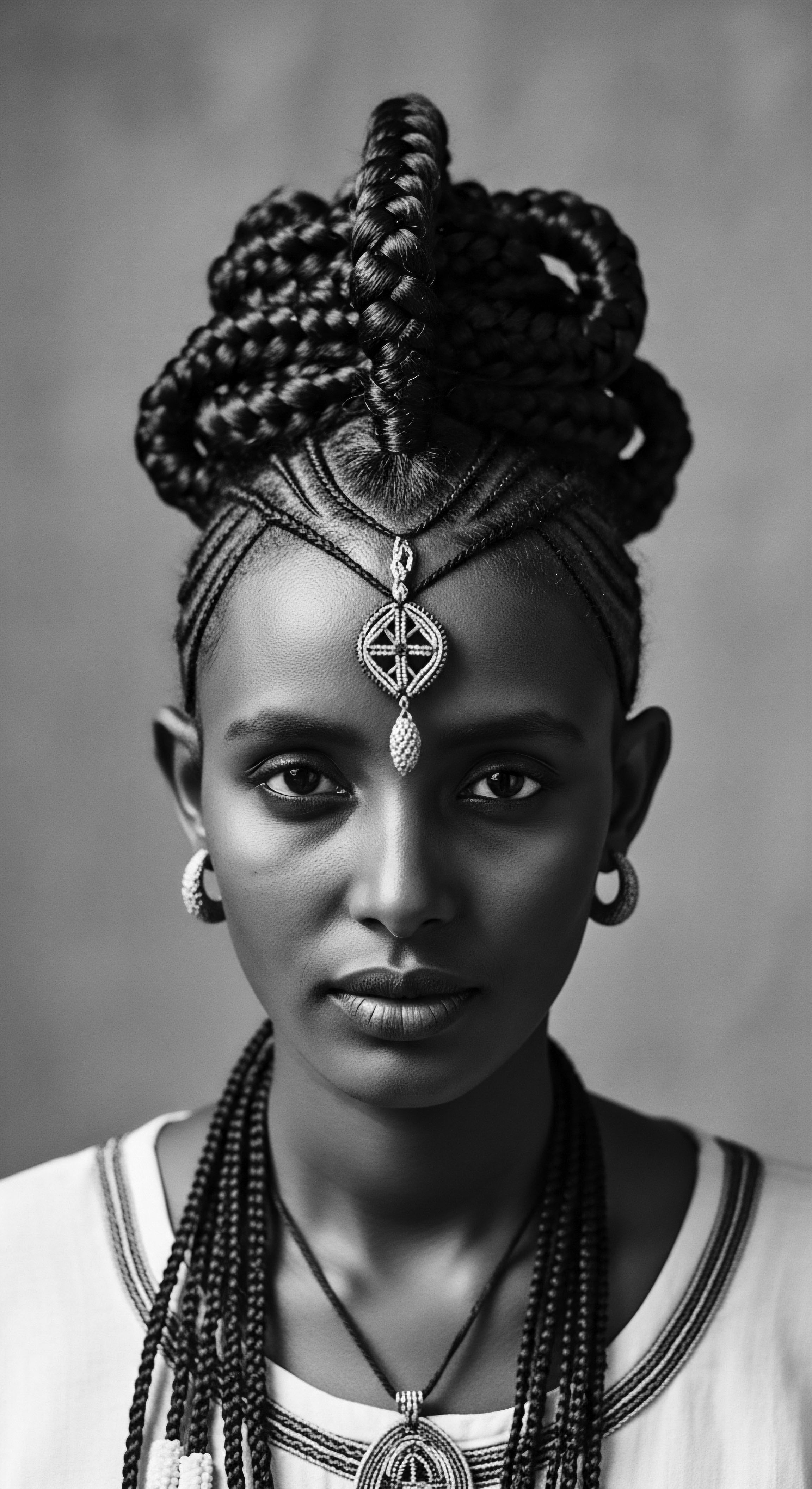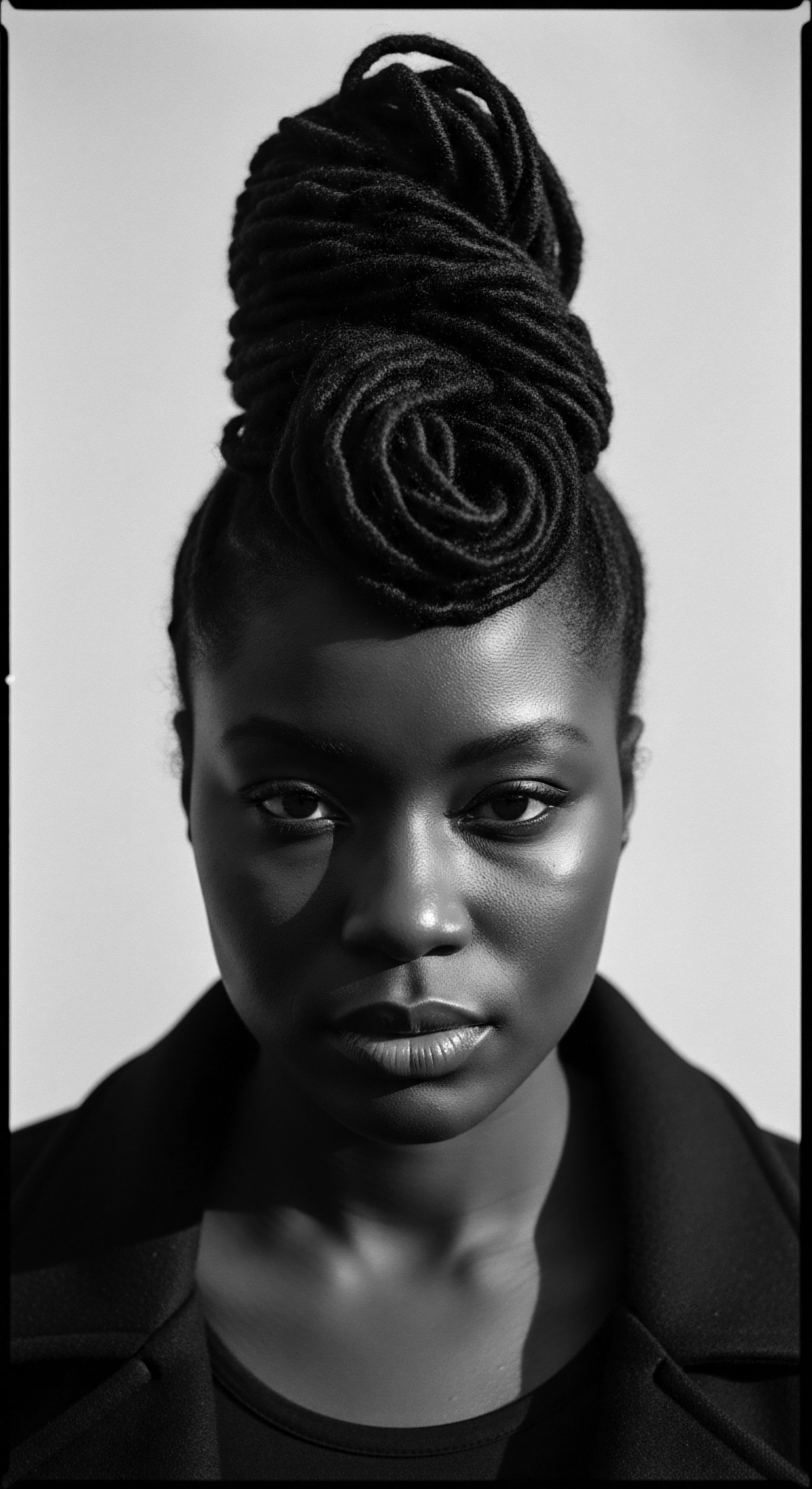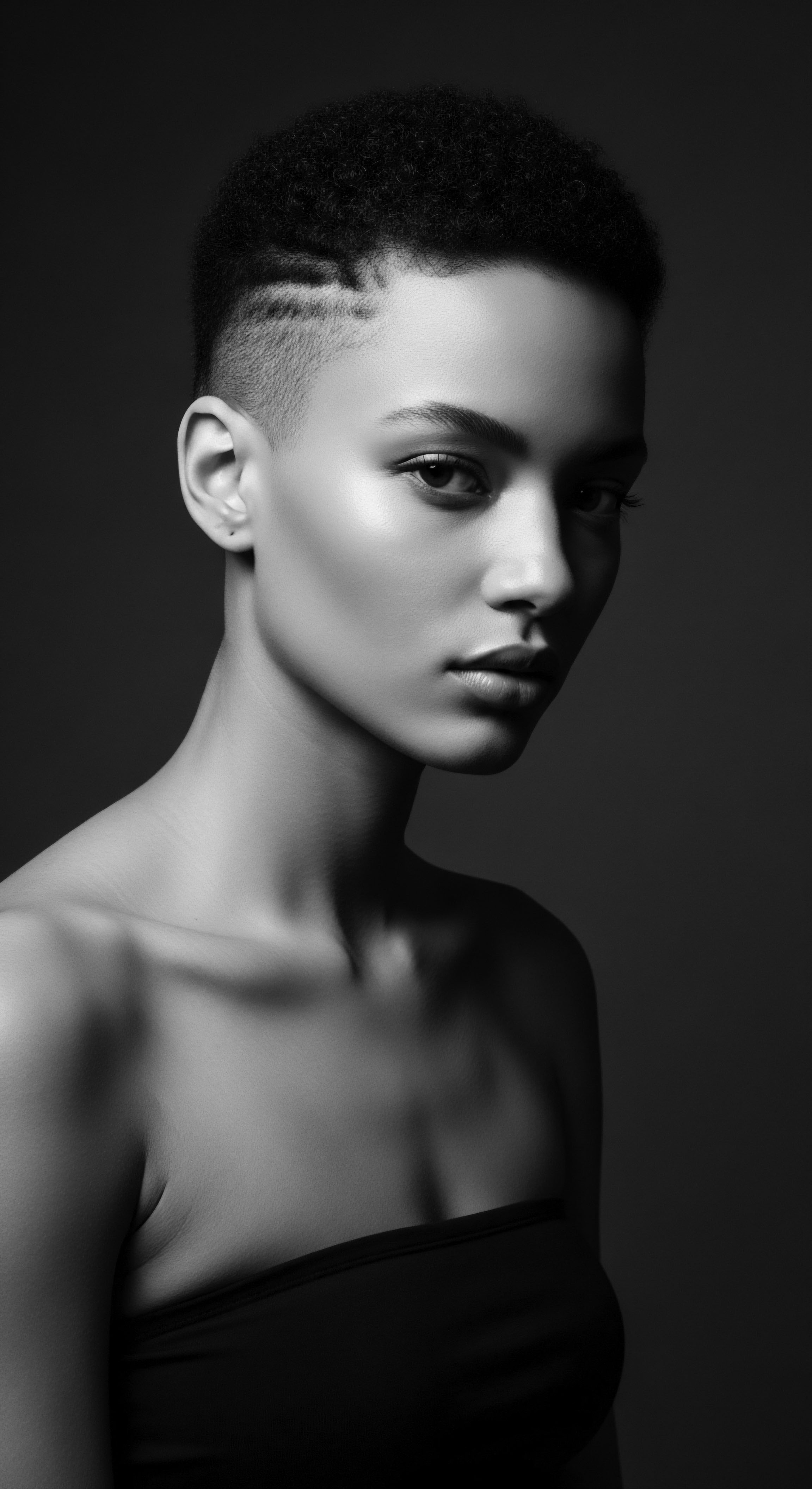
Roots
To truly comprehend how ancient hair traditions serve as custodians of heritage, we must begin at the very source ❉ the physical architecture of textured hair itself. This journey is a quiet unraveling, a mindful descent into the biological blueprint, recognizing that our ancestors, through empirical observation and communal wisdom, understood nuances of hair well before microscopes offered their silent revelations. Each coil, each curve, speaks a language of lineage, a story etched into our very being, passed down through generations.

What Ancestral Voices Whisper About Our Strands?
Consider, if you will, the helix, that fundamental shape of life. In textured hair, this helix often manifests as a complex series of twists and turns along the hair shaft. This inherent structure, a symphony of disulfide bonds and keratin chains, grants our hair its unique volume, its boundless character, and its sometimes-challenging spirit. Our forbears, without formal scientific terms, recognized this distinction.
They understood that a tightly coiled strand behaved differently from a loosely wavy one. Their care practices, rituals refined over millennia, acknowledged these intrinsic differences, intuitively aligning with what modern trichology now affirms about hair’s fragility at points of curvature and its need for particular moisture retention.
For instance, the practices of deep conditioning and regular oiling, so prevalent in West African and diasporic traditions, were not mere aesthetic choices. They were acts of profound scientific wisdom, anticipating the very needs of a hair type prone to dryness due to its molecular configuration and cuticle structure (Kelly, 2012). The natural oils produced by the scalp struggle to traverse the intricate path of a tightly coiled strand, leaving the ends particularly vulnerable. Ancestral knowledge, long before the scientific validation, provided remedies for this innate characteristic.
The physical structure of textured hair inherently informs the ancestral practices that have preserved its vitality and cultural significance through time.
Across diverse African societies, specific terms emerged to categorize hair types, not through numerical scales, but through descriptive words that spoke of texture’s spirit and behavior . One might hear distinctions like “kinky,” “coily,” ““woolly,” or “curly,” each term carrying an implied understanding of how that hair would respond to styling, moisture, and manipulation. These were not arbitrary labels; they served as practical guides for care and adornment within communities, reflecting generations of observation. This informal system, deeply rooted in the communal understanding of hair’s intrinsic nature , allowed for a precision of care that transcended simple aesthetics.

How Do Hair Growth Cycles Echo Lineage?
Our hair, it lives and breathes through cycles ❉ anagen (growth), catagen (transition), and telogen (rest). Ancient traditions, perhaps more keenly than we recognize today, intuitively grasped these rhythms. Hair was seen as a living entity, its vitality connected to overall well-being and the rhythms of nature. The practice of protective styling, for instance, which often involves braiding or twisting the hair close to the scalp, implicitly respects the anagen phase, minimizing manipulation that could lead to breakage and shorten the life of a growing strand.
The rich history of these methods, passed down from elder to youth, forms a living lexicon.
- Cornrows ❉ A deeply significant pattern, often originating from West African communities, where patterns could signify social status, religious beliefs, or tribal identity. During periods of enslavement, these intricate braids also served as clandestine maps and repositories for seeds, a stark example of their dual function as adornment and resistance.
- Bantu Knots ❉ Known for their ability to stretch and define natural curl patterns, these small, coiled buns found throughout Southern Africa served both a utilitarian purpose in protecting hair and an artistic one, symbolizing beauty and readiness.
- Twists ❉ A gentler method of hair manipulation, often used for daily styling or as a foundation for more elaborate looks, with variations seen across African and Caribbean traditions, each carrying distinct cultural meaning.
Environmental factors, deeply understood by our ancestors, profoundly influenced hair health. Diets rich in nutrient-dense, locally sourced foods—think dark leafy greens, root vegetables, and healthy fats from seeds and nuts—provided the building blocks for strong hair, long before biochemistry quantified the role of vitamins and minerals. The relationship between internal health and external radiance was not merely anecdotal; it was a cornerstone of holistic well-being, where the vibrancy of one’s hair was seen as a mirror to the vitality within.
| Ancestral Observation Hair requires moisture and lubrication to stay supple. |
| Modern Scientific Basis Textured hair's coiled structure hinders natural sebum distribution, necessitating external moisturizers and oils to prevent dryness and breakage. |
| Ancestral Observation Protective styles preserve length and strength. |
| Modern Scientific Basis Minimizing manipulation reduces mechanical stress on hair strands, preventing cuticle damage and preserving the integrity of the hair's protein structure. |
| Ancestral Observation Hair health mirrors internal well-being. |
| Modern Scientific Basis Nutrient deficiencies (e.g. iron, zinc, biotin) and systemic health issues can significantly impact hair growth cycles and strand quality. |
| Ancestral Observation The wisdom of ancient hair practices often aligns with contemporary scientific understanding, validating centuries of accumulated heritage. |

Ritual
The preservation of heritage through ancient hair traditions transcends the mere anatomical. It finds its vibrant expression in the living ritual, in the deliberate acts of care and styling that transform hair into a canvas of identity, a declaration of belonging. These rituals, sometimes simple, sometimes elaborate, have been the crucible in which cultural memory has been forged and passed on, their rhythms echoing the collective heartbeat of communities.

What is The Ancestral Significance of Protective Styles?
Protective styling is a venerable practice, its roots deeply embedded in the soil of antiquity across African civilizations and their diasporas. These styles—braids, twists, knots, and wraps—were never simply about aesthetics. They held profound social, spiritual, and practical meanings. For instance, in many West African societies, the specific patterns of cornrows could signify age, marital status, wealth, or tribal affiliation.
During times of conflict, as recounted by historian A’Lelia Bundles (2001) in her work on Madam C.J. Walker, certain styles acted as covert communication, with intricate designs mapping escape routes for enslaved individuals, or concealing seeds and gold for survival. This historical context reveals how seemingly simple hair arrangements became powerful tools of resistance and survival, carrying the weight of ancestral knowledge and resilience .
The very act of styling, often performed in communal settings, reinforced social bonds. Mothers braided daughters’ hair, grandmothers shared tales while twisting intricate patterns, and friends exchanged confidences under the rhythmic pull and release of fingers through strands. These were not just styling sessions; they were oral history lessons, communal therapy, and cultural education, all intertwined with the heritage of touch and tradition .

How Did Traditional Methods Shape Hair Identity?
Natural styling and definition techniques, practiced for centuries, allowed textured hair to be celebrated in its authentic form. The manipulation of coils and curls to create specific shapes and volumes, often aided by natural ingredients, spoke volumes about cultural identity and self-acceptance. Think of the Afro, a style that, while reaching its zenith of prominence in the 20th century, drew upon deep ancestral reverence for natural hair volume and shape as a symbol of pride and power. The deliberate shaping of hair into spheres or elaborate crowns was an ancient practice, predating modern political movements, reflecting a reverence for hair as a manifestation of a community’s spirit.
Ancient hair rituals are not merely aesthetic acts; they are living libraries of cultural meaning, communal bonding, and quiet defiance.
The use of wigs and hair extensions also has a venerable lineage. In ancient Egypt, elaborate wigs, often crafted from human hair, plant fibers, or even wool, symbolized wealth, status, and religious devotion. They served protective purposes against the harsh sun and were adorned with precious metals and jewels.
Later, in various African societies, extensions crafted from woven fibers or additional hair were used to supplement natural hair, allowing for more elaborate and larger-than-life styles that communicated status, marital availability, or spiritual roles. These practices highlight a sophisticated understanding of hair as an adaptable medium for expression and communication, not simply its inherent form.
Even approaches to heat styling, though less common in ancient textured hair practices due to the inherent fragility of the hair type, did exist in rudimentary forms, often using heated combs or stones. However, the prevailing ancestral wisdom, especially concerning highly coiled hair, favored minimal manipulation and gentle methods to preserve hair health, often contrasting sharply with later, more damaging practices introduced through colonial beauty standards. This historical contrast illuminates the resilience of traditional, gentle care in the face of imposed ideals.
| Tool Category Combs and Picks |
| Traditional Examples and Purpose Wooden Combs ❉ Carved from natural materials, used for detangling and creating partings. Often adorned with symbolic carvings. |
| Connection to Heritage Preservation Maintained hair health, enabling styles that codified identity. The act of combing could be a meditative, personal ritual. |
| Tool Category Adornments |
| Traditional Examples and Purpose Cowrie Shells, Beads, Gold Filigree ❉ Integrated into braids or wrapped around locs. Signified status, spiritual protection, or tribal affiliation. |
| Connection to Heritage Preservation Visual markers of identity, wealth, and spiritual beliefs, embodying a community’s artistic and material culture. |
| Tool Category Wraps and Headties |
| Traditional Examples and Purpose Gele (Yoruba), Duku (Ghanaian), Tichel (Ethiopian Jewish) ❉ Elaborate head coverings from various cultures, often made from vibrant fabrics. |
| Connection to Heritage Preservation Protected hair, conveyed status, religious adherence, or personal expression. Each fold and tie could carry specific meaning, reflecting cultural codes. |
| Tool Category The tools of ancient hair care are not inert objects; they are conduits of cultural memory, each carrying stories of innovation and deep-seated identity. |
The ancestral toolkit for textured hair was diverse and practical, reflecting the ingenuity of communities using what was available in their environment. Beyond combs and picks, natural adornments such as shells, beads made from seeds or clay, and precious metals were skillfully incorporated into hairstyles, transforming them into wearable art and cultural statements. These elements were not merely decorative; they were often imbued with spiritual significance, offering protection or serving as talismans. The very materials used and the methods of their application speak to a profound connection to the earth and the communal values that shaped individual and collective heritage .

Relay
To understand how ancient hair traditions preserve heritage fully, we must consider the ‘relay’—the dynamic transmission of knowledge, practices, and identity across generations. This is where the wisdom of the past truly lives, adapting, sometimes silently, sometimes with roaring affirmation, in the present moment. It is in these sustained rhythms of care, in the deliberate choices of what we apply to our strands, and in the collective problem-solving, that heritage finds its most tangible and enduring expression.

How do Ancestral Practices Inspire Modern Hair Regimens?
The construction of a personalized textured hair regimen today, far from being a modern invention, draws deeply from the wellspring of ancestral wisdom. Our ancestors, through trial and observation, developed sophisticated, often localized, systems of care that addressed the unique needs of their hair within their specific environments. They understood the power of natural ingredients sourced from their immediate surroundings. Think of shea butter (Vitellaria paradoxa), harvested for millennia in West Africa, valued for its profound emollient properties and its ability to seal moisture into hair strands.
Or argan oil (Argania spinosa) from Morocco, cherished for its restorative and conditioning qualities. These ingredients, and the methods of their extraction and application, represent a profound scientific and botanical understanding passed down through oral traditions and communal practice.
Today, these ancient practices translate into the fundamental steps of many contemporary textured hair routines ❉ cleansing, conditioning, moisturizing, and protecting. The rhythm of weekly wash days, the dedication to deep treatments, and the emphasis on low-manipulation styles are all echoes of time-honored approaches that prioritized health and length retention. This consistency creates a living connection, where each application of a nourishing balm or each carefully constructed braid becomes a quiet dialogue with those who came before.
The transmission of ancient hair knowledge is a continuous relay, adapting past wisdom to present needs while reaffirming cultural identity.

What is The Historical Basis of Nighttime Hair Protection?
The ritual of nighttime hair protection, particularly the use of head coverings, possesses a deep historical basis that speaks volumes about ancestral ingenuity and care. Long before silk bonnets became a common accessory in modern textured hair care, various forms of head wraps and coverings were integral to preserving hairstyles, protecting strands from environmental damage, and maintaining hygiene across African and diasporic communities. These coverings, often made from cotton, linen, or other locally available fabrics, shielded hair from dust, friction, and moisture loss during sleep. The intent was to extend the life of intricate styles, thereby reducing the need for constant manipulation which could cause breakage.
Moreover, these coverings often carried cultural or spiritual significance, beyond mere utility. In some traditions, head coverings were a symbol of modesty, respect, or even a connection to ancestral spirits. The act of wrapping one’s hair before rest became a private ritual, a moment of mindful preparation that acknowledged the hair’s sacred nature. This practice highlights a holistic understanding of hair care that extended beyond the waking hours, recognizing the continuous need for its well-being.

How Do Ancient Ingredients Power Modern Care?
The compendium of textured hair problem-solving draws heavily from ancestral wisdom, often validated by modern scientific inquiry. Issues like dryness, breakage, and scalp irritation, though framed differently across epochs, have long been addressed through a combination of topical applications and holistic interventions.
Consider the following traditional ingredients and their enduring relevance:
- Aloe Vera ❉ Used for centuries across Africa and the Caribbean for its soothing, moisturizing, and healing properties. Modern science confirms its rich content of vitamins, enzymes, and anti-inflammatory compounds beneficial for scalp health and hair hydration.
- Chebe Powder ❉ Originating from Chadian women, renowned for their long, strong hair. This blend of herbs (including croton gratissimus, prunus mahaleb, and resin) is traditionally applied as a paste to hair to strengthen strands and reduce breakage. Its efficacy lies in creating a protective layer around the hair shaft, minimizing friction and locking in moisture, a testament to empirical observation.
- Rhassoul Clay ❉ Sourced from the Atlas Mountains of Morocco, used for gentle cleansing and detoxification of hair and scalp without stripping natural oils. Its high mineral content helps to improve hair elasticity and texture, a natural alternative to harsh chemical shampoos.
This interplay of ancient remedy and contemporary validation underscores the richness of ancestral knowledge . What our forebears observed and perfected through generations of practical application, modern science often provides the molecular explanation for. This symbiotic relationship strengthens the argument that hair care, particularly for textured hair, is not simply a matter of aesthetics or personal preference; it is a living bridge to our historical and cultural lineage .
The holistic influences on hair health, deeply embedded in ancestral wellness philosophies, also represent a significant aspect of heritage preservation. Many African cultures viewed the body, mind, and spirit as an interconnected whole. Hair, being an outward manifestation of one’s vitality, was therefore intrinsically linked to overall health. Practices such as mindful eating, stress reduction through communal activities, and the use of herbal remedies for internal balance were all understood to contribute to vibrant hair.
This perspective contrasts with a purely superficial approach to hair care, asserting that true radiance emanates from a place of holistic well-being. The continued emphasis on these interconnected elements within textured hair care today is a powerful relay of ancestral wisdom, ensuring that the legacy of care remains deeply rooted in a comprehensive approach to health.

Reflection
As we trace the intricate patterns of how ancient hair traditions preserve heritage, we find ourselves standing at the confluence of past and present, a place where the soul of a strand truly reveals itself. This exploration has been a journey not just through time, but into the very heart of identity, resilience, and wisdom. Textured hair, with its remarkable diversity and profound historical weight, embodies a living archive. Each twist, each curl, carries the echoes of ancestral hands, the whispered stories of survival, and the vibrant declarations of selfhood that have traversed continents and generations.
These traditions remind us that hair care extends beyond cosmetic appeal; it is a profound act of self-reverence, a communal bond, and a silent language. It is a testament to the ingenuity of our forebears, who, without modern scientific tools, cultivated sophisticated understanding of their hair’s unique needs and developed practices that remain remarkably relevant today. The legacy of ancient hair traditions is not static; it is a dynamic, evolving current, continually shaping how individuals of Black and mixed-race descent connect with their roots, express their identities, and envision their futures. By honoring these ancestral practices, we do more than maintain healthy hair; we participate in a continuous relay of heritage, ensuring that the soul of every strand continues to vibrate with the wisdom of ages.

References
- Bundles, A. (2001). On Her Own Ground ❉ The Life and Times of Madam C. J. Walker. Scribner.
- Kelly, A. P. (2012). The Science of Black Hair ❉ A Comprehensive Guide to Textured Hair Care. CreateSpace Independent Publishing Platform.
- Roberts, G. (2003). Hair in African Art and Culture. Museum for African Art.
- Byrd, A. L. & Tharps, L. (2014). Hair Story ❉ Untangling the Roots of Black Hair in America. St. Martin’s Griffin.
- Nelson, A. K. (2020). The Hair Historian ❉ Exploring Hair’s Cultural Meanings and Social Impact. University of Minnesota Press.
- Gittens, S. (2018). Ancient African Hair Traditions ❉ A Guide to Historical Hair Care and Styling. Sankofa Publishing.
